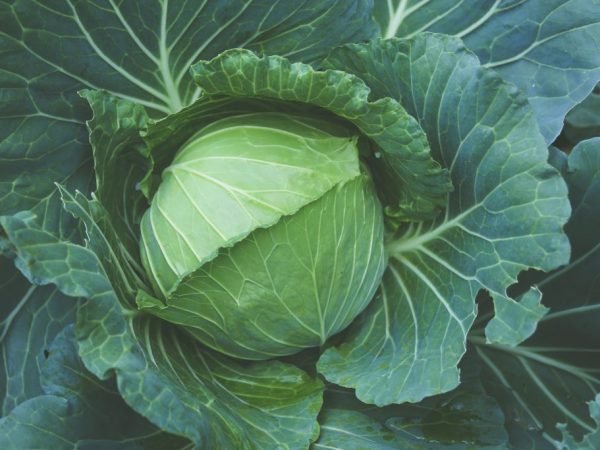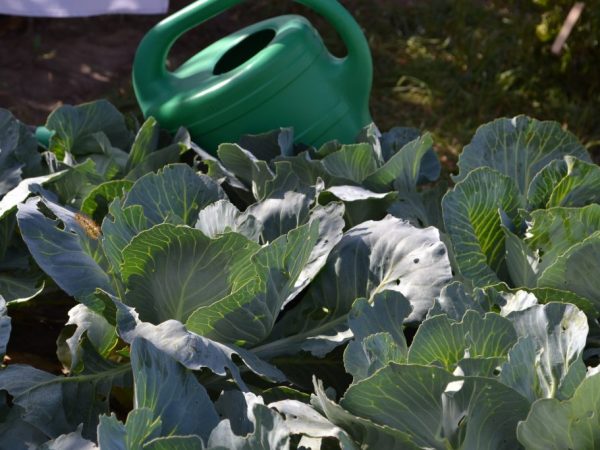Characteristics of the Tochka variety
Cabbage variety Dotchka has an early ripening period. The culture is characterized by the alignment of the forks, which makes it possible to conveniently transport them.

Characteristics of the Tochka variety
Variety characteristics
The first fruits, according to the description, are harvested 90-100 days after germination. Mass ripening falls on days 105-115. The main amount of heads of cabbage is given for the first 2 harvests.
Yield indicators are on average about 4.5 kg of vegetables per 1 sq. m. Under good growing conditions, it can reach 8.1 kg per square meter. m.
Advantages of the variety:
- resistance to cracking;
- excellent commercial qualities;
- immunity to black leg, vascular and mucous bacteriosis;
- amicable ripening of fruits.
Description of the head
The rosette of leaves is half-raised. The diameter ranges from 45 to 70 cm. The leaves are rounded. Their length is 31-43 cm, width - 28-40 cm. The number ranges from 11 to 18. The color is green with a waxy bloom of medium intensity. The surface is slightly wrinkled or smooth. The edge is slightly wavy. Veins are weakly expressed. The petioles of the lower leaves are 6 cm long.
According to the description, the head of cabbage is small: its weight is 0.9-1.2 kg. The shape is rounded or rounded-flattened. The density is average, the inside is loose. The color is light green, on the cut - white with a yellow tint. The length of the outer stump is 5-12 cm, the inner stump is 8 cm. The taste is good. Fresh cabbage is consumed. Early products are being successfully marketed.
Care
Growing conditions
The maximum productivity of the dotted cabbage can be obtained by providing optimal conditions for it. The area set aside for vegetables should be well lit. When planting seedlings in a permanent place, the ambient temperature should be more than 17˚C, and the soil should be at least 14˚C. With sudden changes in temperature, the plants are covered with a special material.
Watering

Cabbage can only be watered with warm water.
White cabbage requires good soil moisture. Watering is given special attention in the first days after disembarkation, as well as during the setting of heads. The introduction of water is limited during the period of filling the culture.
The culture does not tolerate drought, but excess moisture is also bad for development. With excessive moisture, fibrous roots die off. Average liquid consumption - 12-13 liters per 1 sq. m. To do this, take only warm, settled water.
Loosening
So that a dry crust does not form on the soil, it is loosened after each watering or rain. The procedure provides good access of oxygen and moisture to the roots of plants, which makes them stronger. The soil is covered by 4-5 cm. At the same time, weeding is carried out so that the weed does not suppress the plants.
Hilling
The earth is loosened and poured, lifting, around the base of the cabbage. This is done to increase nutrition and retain moisture in the soil. You can also lay a layer of mulch, which is used as peat. It prevents weeds from growing.
Top dressing
White cabbage responds well to soil fertilization. Nutrients are applied 2 times per season:
- 15-20 days after planting;
- 10-15 days after the previous one.
During the first feeding, nitrogen-containing substances are used, which contribute to the intensive growth of green mass. For this purpose, organics or chemicals are used. Consumption - 0.5 l of liquid for one plant. There are different options for their use:
- 0.5 liters of liquid mullein per 10 liters of water;
- 60 g of superphosphate, 200 g of wood ash, 10 liters of water;
- 20 g of ammonium nitrate per 10 liters of water.
Foliar dressing can also be done. The leaves are sprayed with the following solution: 1 matchbox of ammonium nitrate per 10 liters of water.
For the second stage of fertilization for early cabbage, the dosage of the funds is increased to 1 liter for one head of cabbage. The following types of feeding are used:
- mullein infusion, which is prepared in a ratio of 1:10;
- infusion of bird droppings in a ratio of 1:15;
- 0.5 kg of poultry manure or compost, 1 l of ash infusion, 10 l of water;
- 0.5 l of liquid mullein, 0.5 kg of poultry droppings, 30 g of azofoska, 15 g of the preparation "Solution" ("Kristalon", "Kemir");
- 2 tbsp. l. nitrophosphate, 10 liters of water.
Pests and diseases
Great harm to the harvest of white cabbage Tochka is caused by fungi. They, getting on the culture, multiply and lead to the development of diseases.
| Diseases | Prophylaxis | Control methods |
| Keela | Before planting, carefully examine the seedlings; diseased seedlings are not planted. | Damaged plants are removed to prevent the spread of the disease to other cruciferous crops; the soil under the plants is sprinkled with lime. |
| Downy mildew (downy mildew) | Disinfection of soil and planting material; regulation of soil moisture; watering only with warm water; compliance with crop rotation. | Treatment with 1% Bordeaux liquid (200 ml of liquid per 10 liters of water for seedlings, 0.5 liters for adult plants); apply according to the attached instructions "Fitoftorin" and "Ridomil Gold". |
| Fusarium | Remove plant residues; observe crop rotation. | Remove the affected leaves; treated with fungicides "Benomil", "Tecto", "Topsin-M". |
Cabbage Point is highly susceptible to pests. Among them are:
- Cabbage aphids. To combat it, use the infusion of tobacco, garlic. Of the more aggressive means used insecticides "Karbofos", "Karate", "Iskra".
- Cabbage fly. a mixture of tobacco and lime is prepared against it, which are taken in equal parts. The drug "Chlorophos" has an effective effect. A 65% solution of the substance is diluted to a concentration of 0.25%. Consumption - 200 ml.
- Cruciferous flea beetles. They are sprayed with soapy water or powdered with ash. From chemical preparations "Karbofos", "Aktara" are isolated.
Conclusion
The Tochka variety has both strengths and weaknesses. Whether to grow it on your site is up to you. Such cabbage is used only fresh, it is unsuitable for storage.


